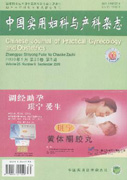Abstract: Objective To investigate the expression and significance of endocrine specific vascular endothelial growth factor (EG-VEGF) in endometriosis and its lateral tissue.Methods Detected the expression of EG-VEGF by immunohistochemistry in 32 cases of endometriosis, eutopic and ectopic endometrium, the lateral tissue of endometriosis, control group 1 (32 case of normal endometrium) and control group 2 (15 cases of normal ovaries).Results The expression and positive expression rate of EG-VEGF in ectopic endometrium were higher than eutopic endometrium[1.99±0.26(84.3%),1.65±0.34(65.6%),respectively](P<0.05 and P<0.01);the expression and positive expression rate of EG-VEGF in eutopic endometrium were higher than control group1[1.65±0.34 (65.6%),0.85±0.29(21.9%),respectively](P<0.05);the expression and positive expression rates of EG-VEGF in ectopic endometrium was higher than ovarian of ectopic lesion side[1.99±0.26(84.3%),[1.45±0.28(56.2%),respectively](P<0.05);the expression and positive expression rates of EG-VEGF in ovarian of ectopic lesion side were higher than control ovarian[1.45±0.28(56.2%), 0.89±0.31(40.0%)respectively](P<0.01 and P<0.05); between the two groups, the differences were highly statistically significant.Conclusion The abnormally high level of EG-VEGF in endometriosis lesions, its side tissue and eutopic endometrium is associated with the occurrence and development of endometriosis.

